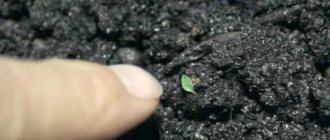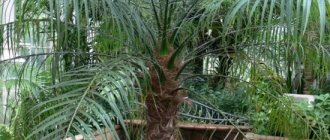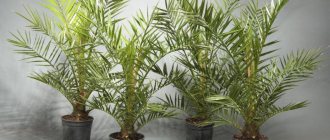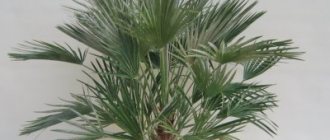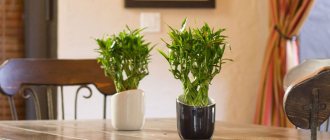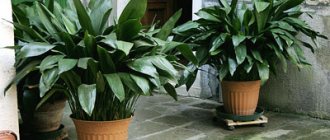Among the exotic indoor plants that immediately attract attention, many gardeners highlight the banana tree. The plant has a very unusual appearance; indoors it can bloom and bear fruit. There are many common misconceptions and interesting facts associated with the indoor banana.
Characteristics and botanical description
A banana is a plant that consists of two parts. The first is the trunk. He "hides" underground. It is interesting that the trunk immediately took on the role of the main root. The upper second part is the leaves. They are wide, large and fit tightly to each other. The leaves can be of different colors - from rich green to burgundy. This indicator depends on the crop variety.
How does a banana grow in nature? Photo.
The plant lives for about 40 years. Moreover, it bears fruit most actively only in the first years. This period lasts approximately 5 years. Later on the plant every year there are fewer and fewer fruits. Therefore, if bananas are grown on farms, then their bushes are specially regularly replaced with new ones. This happens approximately every 5-6 years. Then it is possible to achieve maximum yield.
Today there are many varieties of bananas. They all differ in appearance, productivity, and other characteristics. Some of them are even suitable for growing at home.
| Varieties | Characteristic |
| Velvet, red, purple, lavender | The listed varieties bloom and bear fruit under favorable conditions. However, the fruits themselves are not edible. They are tasteless and contain a huge amount of seeds. Therefore, such bananas are usually grown exclusively for decorative purposes. |
| Tropicana | This is a small plant - up to 1.5 m tall. It has miniature fruits (maximum - up to 10 cm). Bananas are very tasty. They have a bright sweet taste |
| Apple | This variety has an average yield, but very tasty fruits. Ripe fruits have a black peel and an appetizing aroma, immediately reminiscent of a mixture of apple and strawberry |
| Kyiv dwarf | The plant reaches approximately 1.3 m in height. This variety bears a lot of fruit. From just one bush it is possible to collect up to 180 bananas per season. |
| Rose | This is a very beautiful plant. It is an unpretentious perennial and fast-growing. It blooms and bears fruit only in indoor conditions. Pink miniature bananas are ripening. But they are not edible |
| Pygmy | This is another decorative variety. Bananas are grown solely for beauty. They are yellow and small in size |
All varieties of the size discussed have low frost resistance. The plant blooms and bears fruit only in warm conditions. Often - exclusively at home.
Banana grows (photos of it will allow you to get acquainted with different varieties of the plant) in Russia. If you plan to grow it in a garden plot, then it is permissible to plant the crop in warm regions. The Krasnodar region is best suited for this.
Origin of the word "banana"
There is no exact information about the origin of the Latin definition Musa. Some researchers believe that the banana was named in memory of the court physician Antonio Musa, who served in the service of Octavian Augustus, the Roman emperor who ruled in the last decades BC. e and the first years of our era. According to another theory, it comes from the Arabic word “موز”, which sounds like “muz” - the name of the edible fruits produced on this plant. The concept of “banana” passed into the Russian language as a free transliteration of the word “banana” from the dictionaries of almost all European languages. Apparently, this definition was borrowed by Spanish or Portuguese sailors at the end of the 16th and beginning of the 17th centuries from the vocabulary of tribes living in West Africa.
Preparation of planting material and propagation
The easiest way is to buy banana seeds or seedlings right away. This can be done in specialized stores. If you plan to grow bananas at home, then it is better to take seedlings prepared by specialists. The store version is optimally adapted to indoor conditions.
Bananas that are already on store shelves are not suitable for sprouting. Even if seeds are found in the fruit, most of them end up “dead”. Therefore, to independently obtain seeds from a banana, it is best to collect them directly from the fruiting bush. But you can experiment with already ripe store-bought fruit.
Growing from a store-bought banana
To get a new plant from a purchased fruit, you will need to extract the seeds from it.
To do this you should:
- Choose a large banana that is as ripe as possible (but one that has not yet begun to spoil).
- Place the fruit in a bag or simply wrap it in film and leave it like that until its skin completely darkens.
- Peel the skin from the fruit and cut it entirely into 2 equal parts.
- Find and remove the seeds. It is convenient to do this with the sharp end of a knife.
- Place the extracted seeds on a paper towel and carefully examine their appearance. As a result, only round ones should remain. All other seeds can be discarded.
- Thoroughly rinse the suitable material for germination so that even the smallest pieces of fruit pulp are not left on it.
- Pour the prepared seeds with slightly warmed water and put them in this form in a warm place for 50-70 hours.
- Rinse and dry the planting material.
Afterwards, the seeds are laid out in a suitable substrate (neutral) for germination. You can use coconut for this, for example. Sphagnum moss will also work. Both substrate options can be purchased at flower shops. Under the described conditions, seeds can germinate in approximately 2 to 3 months.
From seeds
A banana grows (photos of which are also presented in the article below) from seeds that are covered with a dense shell on top. Therefore, it is not easy to germinate them yourself. If you manage to find suitable high-quality seeds, you will first need to carry out scarification yourself.
In preparation:
- The whole seeds are sent into a small container and filled with warm water.
- They are left in this form for 2-3 days. In this case, the liquid should not cool down much. Cold won't do.
- The already swollen seeds are carefully sawed off. This can be done with a sharp, thin object. It is convenient to use a metal nail file.
At this stage, the seeds will be prepared for further planting.
From the shoot
The best way is to grow a banana from a scion. It is the simplest and fastest. For this method you will need to take a shoot with at least 2-3 leaves. In this case, the length of the workpiece should be no more than 6-8 cm. Too small shoots take root much worse.
When preparing the soil, water it with a small amount of water. It should end up with medium humidity - not too wet and not too dry. Otherwise, the miniature roots will easily bounce off along with lumps of earth. And the gardener needs to preserve as many of them as possible.
It is recommended to send the sprout into the ground in the last month of spring or in the summer. This will make it easier for him to take root and grow further.
How to collect
In most cases, banana fruits are harvested while still unripe so that they ripen during transportation. The fruits do not always have time to ripen, so in supermarkets you can still find greenish fruits, which, after purchase, reach the condition at home.
Let's look at the fruit harvesting process using the example of a banana plantation in Costa Rica:
- As soon as the ovaries begin to grow on the bunch, a plastic cover is immediately put on them - protection from external damage, due to which the fruit will deteriorate even before cutting. The ovaries develop in the sheaths for 11 weeks. This is not full ripening of the banana, but sufficient for picking and transportation. The fruits are cut and hung on a special cable car, along which they are sent to the packaging site.
- The work of collecting bananas is not difficult; only two people can do it. The first cuts off a bunch of fruits with a cleaver tied to a long stick, the second puts the bunches on his shoulders.
- The plant from which the fruit was collected is cut down - it will no longer grow or bear fruit. A fresh sprout is immediately planted in the same place and grows until the next harvest.
- At the packaging station, the bunches are laid out for 20 minutes in a tank with running water until the juice stops oozing from the cuts - otherwise the presentation will deteriorate.
- At the packaging station, the fruits undergo special control, and usually no more than 6% of the product is eliminated. The “rejects” are not thrown away, but put into production - for baby food or baking banana bread.
- The fruits are washed thoroughly. This is what women do.
- After being removed from the water, the bunches are dried, wrapped in plastic film, placed in branded boxes and sent for sale. Transportation most often occurs by sea - it is more convenient and cheaper.
From Costa Rica, goods travel 10 days to the United States, 20 days to Europe. Therefore, more bananas are placed in “European” boxes, since the fruit will dry out slightly during the journey. Depending on the exporting countries, be it Africa, Ecuador or the Canary Islands, delivery conditions and terms may be different.
Preparing the soil and planting site
To plant a plant, you will need to stock up on a small, dense container and soil. At the very beginning, you can use ordinary plastic cups for seeds. These are simple, affordable and budget-friendly tableware options for future bananas.
Of course, the seedlings cannot be left in cups for a long time. As soon as they grow a little, you will immediately need to move the seeds into pots. It is optimal to take containers with a volume of no more than 1.5-2 liters. Smaller sizes can also be used.
To immediately grow seedlings, it is not recommended to take a large container in which the banana will continue to grow in the future. Such dishes will most likely contain excess moisture. Because of it, seedlings can quickly rot and die.
The easiest option is to take a ready-made soil mixture that is suitable for palm trees and other tropical plants. Today they are sold in theme stores with just such a mark. If you couldn’t find special soil, you can prepare suitable comfortable soil yourself.
To do this, take:
- sand and turf - 2 parts each;
- humus – 1 part;
- ash – ½ part.
It is recommended to choose turf from linden, hazel or acacia. But in any case, the prepared soil must first be disinfected. The dishes are prepared in the same way. For example, you can simply pour boiling water over the soil. Another option is to bake the mixture in the oven.
The dishes are first washed thoroughly with running cold water. Be sure to use laundry soap during the process. Afterwards, the containers are also poured with boiling water or wiped with a cloth moistened with a disinfectant.
Before planting, each container is filled with a drainage layer. It is created from pebbles or expanded clay. The drainage should fill the containers approximately 1/3 of the way. It is important to make several punctures in the bottom of the container in which the bananas are planted. This is necessary for the drainage of excess moisture.
Where do bananas grow?
Bananas grow in countries of the tropical and subtropical zone: in South Asia, Latin America, Malaysia, northeastern Australia, and also on some islands of Japan. The banana plant is grown on an industrial scale in Bhutan and Pakistan, China and India, Sri Lanka and Bangladesh, the Maldives and Nepal, Thailand and Brazil. In Russia, bananas grow naturally near Sochi, however, due to the fact that winter temperatures often fall below zero degrees, the fruits do not ripen. Moreover, under prolonged unfavorable conditions, some plants may die.
Landing algorithm
A banana (a photo of which will interest gardeners) grows at home as quickly as possible. In about 3 years you can expect the appearance of about 15 large leaves - long and wide.
The first flowering occurs approximately in mid-summer. During this period, a heart-shaped leaf appears on its upper part. Of light green or cream color. During development, the inflorescence increases in size, and then drops lower and lower.
The above stages continue for up to 3 months. Once the “female” flowers on the plant are pollinated, fruits begin to develop. And the leaves gradually die off. If you provide the crop with proper care, it will begin to actively bear fruit.
To plant seeds you need:
- Dry them thoroughly.
- Lightly press the seeds into the surface of the soil and sprinkle a small amount of soil on top.
- Spray the soil generously with warm water.
- Cover the entire structure with film on top. You can leave it under glass.
If you don’t have pots on hand, you can use plastic containers for the first time. They must be transparent and have lids.
The resulting miniature greenhouse is sent to a warm, bright place. In order for the seeds to germinate well, it is important to monitor the temperature. It should be no lower than 25-27 degrees. Every day, be sure to remove the film for 7-10 minutes. This is required to ventilate the seedlings.
A banana grows (all gardeners should study its photo) with proper preparation quite quickly. The first shoots can be expected in about 50-60 days. When the growth of the seedling has already reached 2 cm, it’s time to send it to a larger container.
Banana composition, vitamins and minerals. What are the benefits of bananas?
Bananas are considered low-fat, but quite nutritious and energy-rich foods. The pulp of its raw fruits consists of a quarter of carbohydrates and sugars, and a third of dry substances. It contains starch, fiber, pectin, proteins and various essential oils, which give the fruit a characteristic aroma. Banana pulp contains useful minerals and vitamins necessary for the human body: potassium, magnesium, phosphorus, calcium, iron, sodium, copper, zinc, as well as vitamins B, E, C and PP . Thanks to its unique chemical composition, the plant has found application in medicine.
Care
It is very important to properly care for the plant. To do this, every gardener needs to carefully study the basic rules of care in advance. These include “water procedures”, feeding, and environmental conditions under which the banana will grow.
Spraying and watering
Bananas love moisture. Such a plant can tolerate a lack of water for no longer than 100 days. Later it begins to slowly die. The optimal humidity level for a banana is 70% and above. To constantly maintain it at normal levels, you need to regularly spray the leaves with water.
The liquid will need to be left for 24 hours in advance and warmed to room temperature. Spraying is recommended every day. It is advisable to place a container of water next to the plant. It is more convenient to use a special humidifier.
To determine the optimal frequency of watering, you will need to evaluate the dryness of the soil. It is recommended to carry out full “water procedures” for bananas at least once every 7 days.
In the process, the plant is sent to the bathroom and thoroughly showered. In this case, excess moisture should drain freely. If the soil is too wet and remains in this state for a long time, then eventually the delicate sensitive roots of the plant will quickly begin to rot.
When checking the dryness of the soil, you just need to take a pinch of it in your fingers and squeeze. An instantly crumbling lump suggests that the plant needs water.
If in the warm season it is best to water the banana at least once a week, then with the onset of cold weather this procedure can be made more rare. Approximately once every 15 days will be sufficient. But at the same time, it is better to leave the daily spraying of the leaves. It is also advisable to wipe them with a damp cloth once a week.
Top dressing
A banana, regardless of the conditions in which it grows, requires regular feeding. Their frequency varies depending on the season. So in the summer you need to feed the crop every week. In winter, the number of procedures is reduced to one every 3-4 weeks.
The easiest way for the procedure under discussion is to take ready-made fertilizer mixtures, formulated specifically for palm trees and other exotic plants. They include the entire necessary list of minerals and nutrients that are required for the normal growth and development of a banana. You can buy these in specialized stores. But you can create the desired mixture yourself.
There are several suitable recipes that you can repeat at home:
- strong fish broth (it is suitable for fertilizing plants above 1 m in height);
- green grass, finely chopped and infused with 1 liter of boiling water for 70 hours;
- humus (200 g per 1 liter of boiling water), infused for 25 hours.
You can't apply fertilizer right away. The soil is thoroughly moistened beforehand. Otherwise, a burn to the root system may occur.
Trimming
Bananas do not need full pruning. It is enough to regularly remove dried and yellow leaves from the plant. If there is a need to stimulate the appearance of new young shoots, then from time to time the bush can be pruned to the very root.
Transfer
A banana that grows at home needs transplanting from time to time. Thematic photos will tell you how to organize this process. If you need to move the culture to a new container, it is recommended to wait until spring. The procedure must be repeated every year.
If the plant is still very young, then it requires replanting approximately once every 6 months. You will need to change the banana pot every time. The size of each new one should be approximately 4-5 cm larger than the previous one. You need to navigate by the diameter of the container.
Before transplanting, the new pot is thoroughly washed and dried. Afterwards, a small layer of drainage is sent to the bottom of the container.
Replanting the plant requires the transshipment method. It is carefully transferred to new prepared containers. The resulting empty spaces are filled with fresh soil. If the plant is already mature, then be sure to renew the entire top layer of soil.
The already transplanted bush is thoroughly watered. There should be enough water so that the soil is completely moistened. After 2 days the soil is loosened. After about another 6-7 days, the plant is fed with the selected fertilizers.
Optimal conditions
In order for a banana to grow and develop well, you need to select optimal conditions for it. The plant feels best at a temperature of 25-35 degrees during the daytime. At night the temperature ranges from 22 to 28 degrees. If the temperature drops to 16 degrees or lower, the crop immediately begins to grow more slowly. If the indicator reaches 0 degrees, then the crop stops growing altogether.
If a banana grows outside and there is a significant drop in temperature around, then you will need to take care of insulating the roots of the plant. The easiest way to do this is to choose sawdust. They scatter over the entire surface of the soil. The top of the structure is covered with cardboard and film.
Bananas thrive best in diffused light. Such conditions are relevant for all tropical plants. To do this, a container with a banana is sent to the windowsill on the eastern or young side of the house. It is important that the plant is not exposed to direct sunlight. Otherwise, serious burns may occur on the leaves. When the weather is sunny and bright outside, the banana needs to be shaded.
It is important that there is at least 10-12 hours of daylight per day. It is difficult to organize such natural conditions in autumn or winter. Therefore, the plant is illuminated with a phytolamp.
How many calories are in a banana?
Data per 100 grams of product:
- calorie content of green banana – 89 kcal;
- calorie content of a ripe banana – 110-120 kcal;
- calorie content of an overripe banana – 170-180 kcal;
- calorie content of dried banana – 320 kcal.
Since bananas vary in size, the calorie content of 1 banana varies between 70-135 kilocalories:
- 1 small banana weighing up to 80 g and up to 15 cm long contains approximately 72 kcal;
- 1 medium banana weighing up to 117 g and more than 18 cm long contains approximately 105 kcal;
- 1 large banana weighing more than 150 g and more than 22 cm long contains about 135 kcal.
Energy value of a ripe banana (ratio of proteins, fats, carbohydrates) (data per 100 g):
- proteins in banana - 1.5 g (~6 kcal);
- fats in banana - 0.5 g (~5 kcal);
- carbohydrates in a banana - 21 g (~84 kcal).
It is important to note that bananas do not cope well with hunger, increasing it after a short-term satiety. The reason lies in the significant sugar content, which rises in the blood and after a while increases appetite.
Food served on banana leaves in India
Possible diseases and pests, ways to get rid of them
If careful, high-quality care is provided for a banana, the plant is extremely rarely exposed to any diseases. Most often, gardeners when growing such crops are faced with gray rot.
This is a fungal infection that occurs and develops due to excessive amounts of moisture in the soil. To determine if there is a problem, you just need to inspect the plant. If the crop is infected, a gray moldy coating will appear on its trunk and leaves.
To cope with rot, you will need:
- Trim off infected areas.
- Completely replace the soil with fresh one.
- Treat the entire plant with copper sulfate. Foundationazole (2%) is also suitable for this.
There are also rare specific fungal diseases of banana.
The table will help you understand them:
| Disease | Peculiarities |
| Panama disease | When disease occurs, the leaves turn yellow and the stem bends. The trunk gradually changes color to red and splits |
| Black Sigatoka | The leaves first become covered with brown spots. Later the latter turn purple. Bananas grown on an infected crop are inedible - very sour |
| Moko's disease | The leaves of the plant turn yellow and wither, the fruits wrinkle. Bananas fall off quickly |
If a plant is found to have one of the listed diseases, it will be very difficult to cure it (they are highly resistant to all antifungal drugs known today). The only option is to completely destroy the banana.
The fruits of the plant under discussion have a bright aroma and sweet taste. Therefore, it attracts a large number of insects. Some you have to deal with even at home. For example, these are nematodes. Such miniature worms enter ripening fruits through roots in the soil. Nematodes lay their eggs there.
It is difficult to notice the problem just by inspecting the plants. But there are some reliable signs of the disease that are important for every gardener to know. These are, for example, black dots on the leaves, which gradually merge into one large spot. Signs of the disease also include cessation of plant growth, yellowing and wilting of leaves, thickening on the trunk and roots.
The problem most often arises due to poorly prepared soil for planting. The use of fresh manure as fertilizer can also lead to the appearance of nematodes.
To deal with the problem, you will need:
- Completely replace the soil with fresh one.
- Disinfect the containers in which the banana will continue to grow.
- Trim parts of the roots with thickenings.
- Soak the remaining roots in hot water for half an hour. The optimal temperature is 45 degrees.
- Treat the entire plant with the medicinal composition. For example, the drug "Vermox", "Bazamid".
The already treated diseased plant should be removed away from any others for about 15 days. During this period, it is best to send the crop to peat.
Another commonly encountered insect is the black weevil. It lives in the soil and feeds on plant sap. The parasite moves in the roots of the crop and leaves behind passages with sticky traces. To determine that the plant is infected, jagged marks on the edges of the leaves will allow you to determine.
The following steps will help you cope with the problem:
- replacing the soil with fresh, uncontaminated soil;
- washing the plant with a cloth with soap dissolved in water;
- treatment of the plant with drugs against parasites (Fitoverm, Aktara).
New soil should be set aside for 3-4 days. It is covered with a film to prevent new insect eggs from getting into the mass.
Another common problem is spider mites. Its appearance on the plant can be immediately noticed. At the same time, the leaves turn yellow and crack over the entire surface. If you turn the leaves over to the other side, you will notice thin cobwebs there. An infected banana stops growing.
To cope with the disease, the plant must be thoroughly rinsed under running warm water in the shower (but not hot). Afterwards, remove all adult insects on the crop with tweezers or other suitable tools.
All that remains is to treat the affected plant with any suitable preparation. For example, “Fitoverm”. An excellent prevention of the problem is the use of an ultraviolet lamp. Treatment for 2-2.5 minutes once a week is sufficient.
Beneficial properties of banana. Uses of bananas
So what are bananas good for?
- Banana pulp is used to relieve inflammatory processes occurring in the oral cavity, and also as a dietary product in the treatment of stomach and duodenal ulcers. In addition, banana is a laxative and is therefore used as a mild laxative. Due to the presence of tryptophan, an amino acid that prevents cell aging and has a beneficial effect on brain function, bananas are recommended for consumption by older people. The presence of potassium and magnesium allows them to be used as a means of preventing high blood pressure and stroke.
- Banana flower infusion helps in the treatment of diabetes and bronchitis. The juice obtained from banana stems is a good anticonvulsant and sedative.
- The invaluable benefits of bananas are concentrated in the peel. Banana skins are used for medicinal purposes. Compresses from young leaves or banana peels promote rapid healing of burns and abscesses on the skin.
- Banana peels are used as fertilizer for both indoor and outdoor flowers. The fact is that it contains a large amount of phosphorus and potassium. Using banana peels you can also fight aphids, which cannot tolerate excess potassium. To do this, you just need to make a tincture on banana skins and water the plants with it. The easiest way to use banana peels to fertilize flowers is to simply bury them in the ground. To do this, just cut the peel into small pieces. After this procedure, even the most tired plants begin to leaf out and bloom. Banana peels take 10 days to decompose in the ground, after which bacteria eat them.
- The benefits of bananas are invaluable: even overripe bananas produce a very powerful antioxidant that prevents cancer.
Residents of countries located in temperate latitudes enjoy eating raw peeled bananas as a dessert and adding them to ice cream and confectionery. Some people prefer dried and canned bananas. This berry is also fried and boiled with or without the peel, adding salt, hot spices, olive oil, onion or garlic. Bananas can be used to make flour, chips, syrup, marmalade, honey and wine. In addition to the fruit, banana inflorescences are also eaten: raw inflorescences are dipped in sauce, and boiled ones are added to gravies or soups. Starch is prepared from unripe banana fruits. Boiled waste from vegetable and dessert bananas is used as feed for large and small livestock.
The fruits and other parts of the banana are used:
- in the leather industry as a black dye;
- in the textile industry for the production of fabrics;
- for the production of especially strong marine ropes and ropes;
- in the construction of rafts and the manufacture of seat cushions;
- as plates and trays for serving traditional South Asian dishes in India and Sri Lanka.
How to make banana leaf plates
Banana fiber
Peculiarities
Growing bananas at home is a very exciting and interesting process. This is its main advantage. With proper care, you can soon get a beautiful, spectacular and unusual plant. The bananas on it may not be edible, but they become a real decoration for the windowsill.
Among the disadvantages of growing one can note the need for regular high-quality care. You will need to devote time to the plant every day. For example, spray the leaves with water, monitor the room temperature and lighting.
If the leaves of the plant turn brown and begin to dry out, this means that it is watered too often. As a result, the roots of the culture began to rot. It happens that even under favorable conditions, a plant suddenly stops growing.
In this case, it needs to be transplanted urgently. And the damaged roots should be cut out and sprinkled with crushed charcoal (both charcoal and activated charcoal will do). If the leaves on the plant begin to dry, it means there is low air humidity in the room. And their yellowing indicates that the temperature is too low.
Having decided to grow a banana, a gardener should find out as much information as possible about this crop and study its numerous photos. Even at home it grows well. Of course, this requires quality care.
Banana palm and banana tree. Do bananas grow on palm trees?
Sometimes a banana is called a banana palm, which is incorrect, since this plant does not belong to the palm family. The banana is a fairly tall plant, so it is not surprising that many people mistake it for a tree. The Greeks and Romans spoke of it as “the wonderful Indian fruit tree” - from here, by analogy with other fruit trees of the region, the expression “banana palm” spread.
The phrase "banana tree", which is sometimes called the banana, actually refers to plants from the genus Asimina, family Annonaceae, and is associated with the similarity of the fruits of these trees to those of the banana.
A banana is not a fruit, a tree, or a palm tree. In fact, a banana is a herb (herbaceous plant), and the banana fruit is a berry!
Interesting facts about bananas
- Among the world's agricultural crops, banana ranks fourth in popularity after wheat, rice and corn. The total number of bananas eaten per year by the world's population exceeds 100 billion.
- The islands of the Malay Archipelago are the birthplace of the banana. Residents of the archipelago have been growing this berry since ancient times and eating it along with fish.
- The first mention of the plant as an edible fruit appeared between the 17th and 11th centuries BC. e. in the Indian written source Rig Veda.
- In the collection Ramayana (Indian epic of the 14th century BC), one of the books describes the clothes of the royal family, which were woven from threads obtained from banana leaves.
- The Goldfinger banana variety, grown in Australia, has fruits that resemble apples in structure and taste.
- If you compare a banana and a potato, it turns out that the calorie content of a potato is one and a half times lower than that of a banana. And raw bananas are almost 5 times less caloric than dried ones. Among the products prepared from this fruit, banana juice is the lowest in calories.
Did you like the article? Share with your friends:
Growing bananas at home
Many types of bananas can be cultivated in a greenhouse or even an apartment. Low-growing banana varieties with variegated decorative leaves and beautiful flowers are best suited for home cultivation. For the plant to feel comfortable, it needs a special substrate consisting of a mixture of universal soil, perlite and finely chopped pine, fir or spruce bark.
Watering a banana
Homemade banana is very demanding of moisture, but you should not over-water the plant. It is not recommended to place indoor bananas near central heating radiators or heating devices. To create the necessary humidity, the leaves and false trunk of the banana are sprayed with a spray bottle. For irrigation, settled water with a temperature of 25°C is used. Watering should be carried out without allowing the substrate to dry out by more than 3 centimeters. During the winter months, banana watering is limited.
Indoor banana fertilizer
To provide homemade banana with microelements, root and leaf feeding is carried out. It is advisable to alternate the use of mineral and organic fertilizers. In any case, you should not feed the plant more than once every 2 weeks. Root loosening of the soil, which provides free access of oxygen to the roots of the plant, has a good effect on the growth of bananas.
